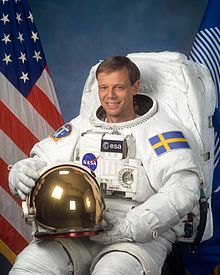Christer Fuglesang: Difference between revisions
m +iw fi: |
|||
| Line 66: | Line 66: | ||
[[no:Christer Fuglesang]] |
[[no:Christer Fuglesang]] |
||
[[pl:Christer Fuglesang]] |
[[pl:Christer Fuglesang]] |
||
[[fi:Christer Fuglesang]] |
|||
[[sv:Christer Fuglesang]] |
[[sv:Christer Fuglesang]] |
||
Revision as of 01:58, 10 December 2006
Christer Fuglesang | |
|---|---|
 | |
| Nationality | Swedish |
| Occupation | Physicist |
| Space career | |
| Astronaut | |
| Rank | Astronaut, ESA |
| Selection | 1996 NASA Group |
| Missions | STS-116 |
Arne Christer Fuglesang (born March 18, 1957) is a Swedish astronaut. He was scheduled to go on the STS-116 Shuttle mission on December 8, 2006, to become the first Scandinavian in space. However, the launch was postponed due to bad weather conditions. The launch is now scheduled for December 9.
Education
Christer Fuglesang was born in Stockholm, Sweden to a Swedish mother and a Norwegian father. He received a master of science degree in engineering physics from the Royal Institute of Technology (KTH), Stockholm, Sweden, in 1981, and received a doctorate in experimental particle physics from Stockholm University in 1987. He became a Docent in Particle Physics at the University of Stockholm in 1991.
Experience
As a graduate student, Fuglesang worked at CERN (European Research Center on Particle Physics) in Geneva on the UA5 experiment, which studied proton-antiproton collisions. In 1988 he became a Fellow of CERN, where he worked on the CPLEAR experiment studying the subtle CP-violation of Kaon-particles. After a year he became a Senior Fellow and head of the particle identification subdetector. In November 1990, Fuglesang obtained a position at the Manne Siegbahn Institute of Physics, Stockholm, but remained stationed at CERN for another year working towards the new large hadron collider project. Since 1980, when stationed in Sweden, Fuglesang taught mathematics at the Royal Institute of Technology.
In May 1992, Fuglesang was selected to join the Astronaut Corps of the European Space Agency (ESA) based at the European Astronaut Centre (EAC) in Cologne, Germany. In 1992 he attended an introductory training programme at EAC and a four-week training program at TsPK (Cosmonauts Training Center) in Star City, Russia, with a view to future ESA-Russian collaboration on the Mir Space Station. In July 1993, he completed the basic training course at EAC.
In May 1993, Fuglesang and fellow ESA astronaut, Thomas Reiter, were selected for the Euromir 95 mission and commenced training at TsPK (Moscow) in preparation for their onboard engineer tasks, extra-vehicular activities (spacewalks) and operation of the Soyuz spacecraft. The Euromir 95 experiment training was organized and mainly carried out at EAC.
On 17 March 1995, he was selected as a member of Crew 2, the backup crew for the Euromir 95 mission, joining Gennadi Manakov and Pavel Vinogradov. During the mission, which lasted 179 days, Fuglesang was the prime crew interface coordinator. From the Russian Mission Control Center (TsUP) in Kaliningrad, he was the main contact with ESA Astronaut, Thomas Reiter, on Mir, and acted as coordinator between Mir and the Euromir 95 Payloads Operations Control Center, located in Oberpfaffenhofen, Germany, and project management. Between March and June 1996, he underwent specialized training in TsPK on Soyuz operations for de-docking, atmospheric re-entry and landing.
NASA experience

Christer Fuglesang entered the Mission Specialist Class at NASA Johnson Space Center, Houston, in August 1996, and qualified for flight assignment as a mission specialist in April 1998. From May to October 1998, he resumed training at TsPK on Soyuz-TM spacecraft operations for de-docking, atmospheric re-entry and landing. He was awarded the Russian Soyuz Return Commander certificate, which qualifies him to command a three-person Soyuz capsule on its return from space.
In October 1998 he returned to NASA-JSC and was assigned technical duties in the Astronaut Office Station Operations System Branch on Russian Transfer Vehicles (i.e. Soyuz and Progress). Later he worked as prime Increment Crew Support Astronaut for the Expedition Corps of the 2nd International Space Station increment crew. Christer Fuglesang has continued with some scientific work and was involved with the SilEye experiment which investigated light flashes in astronauts eyes on Mir between 1995 and 1999. This work is continuing on the International Space Station (ISS) with the Alteino and ALTEA apparatuses. The former is on ISS since 2002, the latter is planned to fly to the ISS in 2005. He has also initiated the DESIRE project to simulate and estimate the radiation environment inside ISS.
Christer Fuglesang is a member of ESA’s European Astronaut Corps, whose home base is the European Astronaut Center located in Cologne, Germany. He is assigned collateral duties in the NASA-JSC Astronaut Office and most recently was assigned to the ISS Payload Branch. Currently, he is assigned to the crew of STS-116, an assembly and crew-rotation mission to the International Space Station. This flight is called Celsius Mission by ESA.
Trivia
- Was once a Swedish national Frisbee champion, holding the national title in "maximum time aloft" in 1978. Fuglesang will take one of his personal Frisbees to the International Space Station.
- His surname Fuglesang means bird singing in Danish. [1]
